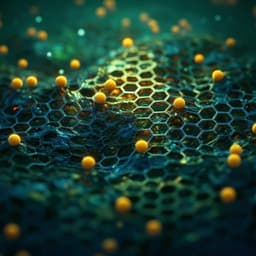
Earth Sciences
Particulate organic matter as a functional soil component for persistent soil organic carbon
K. Witzgall, A. Vidal, et al.
Explore the groundbreaking research conducted by Kristina Witzgall and colleagues, which uncovers the crucial role of soil structure in the persistence of organic matter. This study emphasizes how particulate organic matter, traditionally viewed as a labile carbon source, plays a pivotal role in soil carbon dynamics. Discover the findings that could reshape our understanding of soil health and carbon storage!
~3 min • Beginner • English
Introduction
Soils, sustained by continuous plant-derived carbon inputs, contain the largest terrestrial carbon pool, and microbial decomposition determines the transformation of plant litter into soil organic matter (SOM). Microbial activity is regulated by the soil’s physical structure, which shapes pore networks, gas and water movement, and microbial access to substrates. Increasingly, SOM persistence is recognized to depend more on soil structure-driven mechanisms—aggregation and mineral associations—than on inherent chemical recalcitrance. SOM is often conceptualized into particulate organic matter (POM) and mineral-associated organic matter (MAOM). Microscale biogeochemical interfaces among plant litter, microbes, and minerals are hotspots where transformation and stabilization occur. This study investigates how soil texture governs the pathway of litter-derived carbon from plant residues into persistent SOM pools. Using a 95-day microcosm incubation with 13C-labeled litter in two contrasting textures, the authors quantify interactions between microbial litter decay, aggregate formation (occlusion of POM), and organo-mineral association (MAOM formation) at plant–soil interfaces. The objective is to assess how soil structure controls microbial activity and the parallel formation of persistent carbon pools across depth and fractions, and to visualize these processes at the nano-scale.
Literature Review
Prior work suggests SOM persistence is driven by physical protection and mineral association rather than chemical recalcitrance. SOM is broadly partitioned into POM (largely plant residues) and MAOM (organic matter adhered to mineral surfaces). Soil structure and pore size distributions regulate substrate accessibility and microbial community niches, thereby influencing carbon turnover and stabilization. Microscale hotspots at biogeochemical interfaces (plant litter–microbe–mineral) are crucial for SOM formation. Mechanistic pathways include occlusion of organic matter within aggregates and sorption/association with reactive mineral surfaces. Fungi, due to filamentous growth and ability to traverse heterogeneous pore networks, can play a key role in litter decomposition and in translocating and stabilizing carbon within soil aggregates.
Methodology
Study site and sampling: Agricultural Cambisol in Southern Germany (Freising, Bavaria; 5–20 cm Ap horizon) collected in Dec 2017. The base soil (silty clay loam: 32% clay, 53% silt, 14% sand) was dried, sieved (<2 mm), and plant remains removed. Two textures: fine-textured original soil and a coarse-textured soil created by mixing with quartz sand to 60% sand (sandy clay loam; 24% clay, 15% silt, 60% sand).
Experimental design: Four treatments (two textures × litter vs control), each with five replicates. Microcosms (5 cm height, 5 cm diameter) were packed to consistent bulk density (0.9–1.3 g cm−3): 90 g (fine) and 120 g (coarse). For litter treatments, 330 mg of 13C-labeled maize stalks (2–3 mm; δ13C ≈ −2129‰ V-PDB) were mixed into the top 1.67 cm to simulate a litter layer. Controls received no litter. Microcosms were sealed below with gauze, placed in 475 ml jars with gas diffusion ensured, and incubated 95 days at 21 °C and 60% water holding capacity.
Respiration and isotopes: Headspace gas sampling on days 2–95; CO2 concentration and 13C abundance measured via GC/IRMS with calibration standards. Partitioning of CO2 into litter-derived and soil-derived components used isotopic mixing. Priming effects calculated as differences in native CO2 relative to controls.
Post-incubation sampling: Each microcosm was cut into three equal-depth layers (top, center, bottom). Subsamples were freeze-dried for microbial analyses; others dried for fractionation. Selected POM particles were hand-picked for imaging.
Physical fractionation: Combined density and size fractionation using Na polytungstate (1.8 g cm−3) to isolate free POM (fPOM), then ultrasonic dispersion (440 J ml−1) to release occluded POM (oPOM), including an oPOM<20 µm (oPOMsmall) subfraction; mineral-associated fraction <20 µm combined as MAOM. Fractions were desalinated and cleaned thoroughly. C, N, and 13C contents of bulk and fractions measured by EA-IRMS.
13C CP-MAS NMR: Solid-state 13C NMR on POM fractions to quantify chemical shift regions (alkyl, O/N alkyl, aromatic, carbonyl/carboxyl) and compute alkyl:O-alkyl ratios; molecular mixing model used to estimate compound classes (e.g., carbohydrates, lignin).
PLFA and PLFA-SIP: Lipid extraction (Bligh-Dyer), separation, methylation to FAMEs, GC-FID quantification; biomarkers assigned to gram-positive, gram-negative bacteria, fungi; total bacteria computed from multiple markers. 13C incorporation corrected for added methyl carbon and calculated as proportions within microbial groups and relative to total enriched FAs.
SEM and NanoSIMS: Hand-picked POM mounted on graphene substrates, gold-coated, imaged by SEM. NanoSIMS 50L measured secondary ions (12C−, 13C−, 12C14N−, 16O−, 28Si−, 27Al16O−, 56Fe16O−). Acquired ion images (25×25 μm, 40 planes) processed for drift/dead-time correction. Regions of interest included fungal hyphae, bacteria, EPS patches, and exposed POM; computed 13C−:(12C−+13C−) and 12C14N−:(12C−+12C14N−) ratios. Controls ensured natural abundance baselines.
Statistics: Normality (Shapiro–Wilk) and homoscedasticity (Bartlett) checks; transformations as needed. Between-texture and treatment differences by unpaired t-tests or Wilcoxon tests; depth differences by ANOVA with Tukey HSD or Kruskal–Wallis as appropriate (P<0.05 significant). Analyses conducted in R.
Key Findings
- Respiration and priming: Coarse-textured soil showed higher cumulative native respiration (89.4 mg CO2–C g−1 Cbulk) than fine-textured soil (55.3 mg CO2–C g−1 Cbulk; P<0.001, t=7.512, df=8) and higher net litter-derived CO2 (40.4 vs 24.6 mg CO2–C g−1 Cbulk; P<0.001, t=−6.593, df=8). Litter contributed ~30% of total respiration in both textures. The litter-induced net priming effect was larger in the coarse-textured soil (23.3 mg CO2–C g−1 Cbulk) than in the fine-textured soil (10.8 mg CO2–C g−1 Cbulk; P<0.001, t=−7.686, df=8).
- Fractional C allocation: Soil-derived C was similarly distributed across fractions in both textures, with MAOM dominating storage. Litter-derived C occluded within aggregates (oPOM) was significantly higher in coarse texture (71.1 mg C g−1 Cbulk) than fine texture (36.8 mg C g−1 Cbulk; P=0.007, t=5.03, df=4). Litter-derived C in MAOM tended to be higher in the coarse texture (101.3 vs 48.8 mg C g−1 Cbulk; P=0.08, W=0). Trends of higher oPOM and MAOM litter-C extended with depth to the center layer (P≈0.06).
- Chemical composition (13C NMR): fPOM was dominated by carbohydrates (O/N alkyl C). Litter addition increased the O/N alkyl C region intensity in oPOM of both textures, indicating polysaccharide dominance. Molecular mixing model showed increased carbohydrates (+26% coarse; +20% fine) and decreased lignin (−12% coarse; −10% fine) in oPOM with litter. Aliphaticity (alkyl:O-alkyl ratio) decreased in oPOM versus controls, consistent with incorporation of fresh, carbohydrate-rich litter.
- Microbial community and labeling (PLFA/PLFA-SIP): Litter slightly increased total PLFA in top layers (coarse: +61 nmol g−1 mg soil C−1, P=0.07; fine: +76 nmol g−1 mg soil C−1, P=0.10); middle and bottom layers were similar to controls. Fungal biomarkers responded most strongly: top layer increased 5.4× in coarse (P=0.01) vs 2.6× in fine (P=0.15). In coarse texture, fungal markers also increased in the center layer (2.1 vs 0.4 nmol g−1 mg soil C−1 in control; P=0.02). Proportion of 13C-enriched FAs within groups was highest for fungi (92% coarse; 82% fine; P=0.11). Gram-negative bacterial enriched proportions were significantly higher in coarse texture at all depths (P=0.004, 0.019, 0.0007), indicating greater access to labile litter C.
- Microscale interfaces (SEM/NanoSIMS): Biofilm-like EPS with high 12C14N signal covered large areas of POM surfaces, intertwined with 13C-labeled fungal hyphae and bacteria. Clay-sized minerals were enclosed within EPS on POM surfaces. 13C enrichment (atom %) was high in hyphae (~3.0%), EPS (~3.0%), and bacteria (~2.3%), all above natural abundance (~1.1%); hyphae were significantly more enriched than bacteria and POM. EPS and microbes were N-enriched relative to underlying POM. These observations indicate direct formation of organo-mineral associations and aggregate nucleation at fresh litter surfaces.
Discussion
The study demonstrates that soil texture modulates microbial activity and C cycling dynamics, with coarse-textured soil enabling greater accessibility to litter in larger pores, resulting in higher litter decomposition and a stronger priming of native soil C. Fungal communities thrived under coarse-textured conditions, with a large fraction of their biomass directly derived from litter, highlighting fungi as key agents in rapid litter decay and in translocating litter-derived C away from the detritusphere into deeper layers. The expansion of hyphal networks and EPS production promotes incorporation of fresh litter into aggregates and the occlusion of POM (oPOM), as well as the adhesion of microbially processed C to minerals (MAOM). Crucially, high-resolution imaging shows that at plant–soil interfaces, EPS and microbial biomass on fresh POM surfaces physically glue fine minerals, fostering aggregate formation and organo-mineral associations. These two stabilization pathways—aggregate occlusion of POM and mineral association of OM—occur concurrently at litter surfaces irrespective of soil texture. Thus, particulate organic matter is not merely a labile substrate but a functional nucleation site where microbial processes directly determine the persistence of soil organic carbon.
Conclusion
By integrating isotopic tracing, fractionation, microbial lipid analyses, and nanoscale imaging, the study shows that particulate organic matter surfaces act as hotspots where microbial activity simultaneously drives (i) occlusion of litter-derived POM within aggregates and (ii) formation of mineral-associated organic matter. Coarse-textured soils enhance microbial (especially fungal) activity, litter decomposition, and priming, and promote downward translocation of litter-derived C, but the fundamental stabilization mechanisms operate at litter–mineral–microbe interfaces regardless of texture. These findings reposition POM from an exclusively labile pool to a functional component central to SOC persistence through aggregate and organo-mineral association formation at plant–soil interfaces.
Limitations
Related Publications
Explore these studies to deepen your understanding of the subject.







